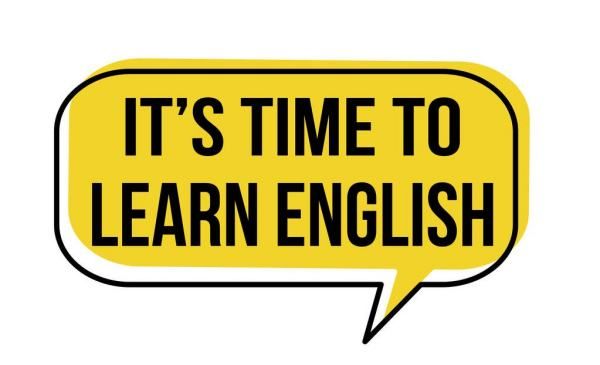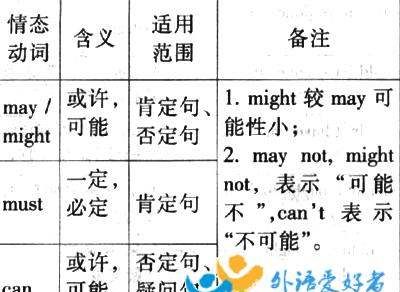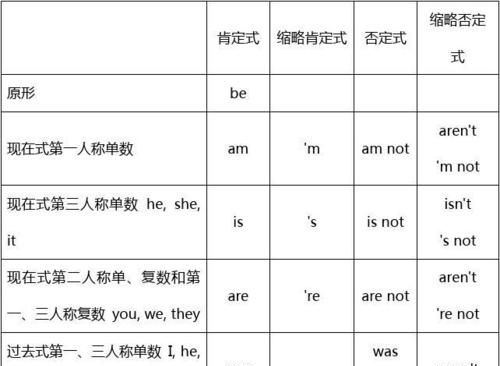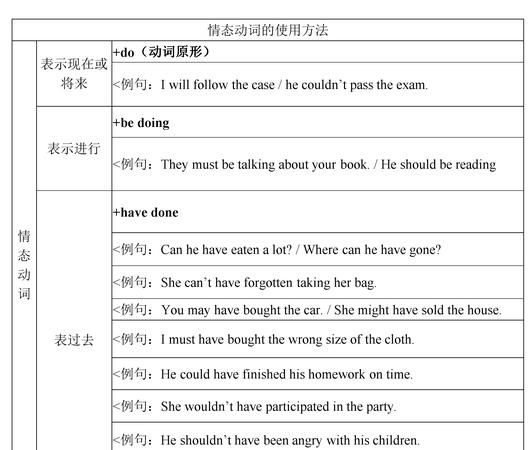本文目录
情态动词的基本用法归纳
以下是情态动词的基本用法
(一)情态动词的特点
情态动词,在英文中主要用来表示说话人的看法、态度等。它很接近中文里的能愿动词。从用法上来说,它有这样几个特点:
1. 各个情态动词自身都有一定的词义。
2. 情态动词不能在句中独立担当谓语。
3. 情态动词在句中不受任何人称、性、数变化的影响。
4. 情态动词后接的不定式(除ought外)都不带to,即接动词原形。
(二)常用情态动词的基本用法
英文中的情态动词主要有:can, could; may, might; must; ought; need; dare, dared,另外,shall, will, should, would在一定的场合也可用作情态动词。
He can speak five languages. 他会说五种语言。
She must have arrived home by now. 现在她准到家了。
We should study hard for our motherland. 我们应该为祖国而努力学习。
They needn’t be in such a hurry for there is enough time for them.
他们还有足够的时间,用不着这么慌张。
1. can, could 能,会
could可以看作是can的过去式,这两个词除了时态不相同外,在表达意思的许多方面是相同的。当然could也有自己独特的用法。
(1)表示脑力或体力上的能力
Nobody can stop the development of science. 谁也无法阻止科学的发展。
She can sing that song in English. 她能用英文唱那歌。
He can submerge to a depth of about twenty meters. 他能潜入约二十米深的水中。
He could hardly support his family before he found the new job.
他在找到那份新工作前几乎无法养家。
I could not understand the lecture on the computer given by Mr. Smith.
我听不懂史密斯先生作的那个关于计算机的讲座。

(2)表示客观上的可能性
You can borrow this useful book from the library.
你可以从图书馆借到这种有用的书。
A more suitable person than him for the job cannot be found.
不可能找到比他更适合这份工作的人了。
Now people can skate on the lake. 现在人们可以在湖上滑冰了。
When the storm stopped, the plane could take off. 当风暴停下来时,飞机可以起飞了。
(3)表示主观上的允许
Can I ask you some questions about it? 我可以问你有关这件事的几个问题吗?
You cannot leave here till I come back. 直到我回来你才能离开。

Such kind of thing can’t happen anymore later. 这类事以后不准再发生了。
Can you tell me how to get to the airport? 你能告诉我怎么去机场吗?
Could you tell me how to get to the airport? 您能告诉我怎么去机场吗?
Could I be forgiven my negligence? 请原谅我的疏忽,行吗?
(4)表示猜测、怀疑或惊诧(用于否定句、疑问句或感叹句中)
How can / could you be here? 你怎么会在这儿?
She couldn’t / can’t be so stupid to do that. 她不可能蠢得去做那种事吧。
He couldn’t / can’t be over seventy. 他不可能有七十多岁了。
Where could / can the boy be now? 那孩子现在能在哪儿呢?
英语情态动词的特点
情态动词无人称和数的变化,情态动词后面跟的动词须用原形,否定式构成是在情态动词后面加 not。个别情态动词有现在式和过去式两种形式,过去式用来表达更加客气,委婉的语气,时态性不强,可用于过去,现在或将来。情态动词属非及物动词,故没有被动语态。
He could be here soon.
他很快就来。
We can't carry the heavy box.
我们搬不动那箱子。
I'm sorry I can't help you.
对不起,我帮不上你。
基本助动词与情态助动词最主要的区别之一是:基本助动词本身没有词义,而情态助动词则有自己的词义,能表示说话人对有关动作或状态的看法,或表示主观设想:
What have you been doing since? (构成完成进行体,本身无词义)
你一直在干什么?
I am afraid I must be going. (一定要)
恐怕我必须走了
You may have read some account of the matter. (或许已经)
你可能已经读过关于这件事的一些报道
除此之外,情态助动词还有如下词法和句法特征:
1) 除ought和used和have to以外,其他情态动词后面只能接不带to的不定式。如果我们把ought to和used to看做是固定词组的话,那么,所有情态动词无一例外地只能接不带to的不定式:
We used to grow beautiful roses.我们过去常常种这种漂亮的玫瑰花
I asked if he would come and repair my television set.我问他是否来修我的电视机
2) 情态助动词在限定动词词组总是位居第一:
They need not have been punished so severely.
他们不需要如此严厉的惩罚
3)情态助动词用于第三人称单数现在时的时候,没有词形变化,即其词尾无-s形式:
She dare not say what she thinks.
她不敢说她是怎么想的
4) 情态动词没有非限定形式,即没有不定式和分词形式,也没有相应的动名词:
Still,she needn't have run away.
不过,她不必跑了
5)情态助动词的“时”的形式并不是时间区别的主要标志。在不少场合,情态助动词的现在时和过去时形式都可以表示现在、过去或将来时间:
Would you mind very much if I ask you to do something?
你会很介意如果我让你做什么?
She told him he ought not to have done it.
她告诉他他不应该这样做
6) 情态助动词之间是相互排斥的,即在一个限定动
词词组中只能出现一个情态助动词,但有时却可以与have和be基本助动词连用:
You should have washed the wound.
你应该已经洗好了伤口
Well,you shouldn't be reading a novel.
嗯,你不应该读一本小说
7)情态动词must一般疑问句否定回答要用needn't而不是mustn't。
Must I read books every day、我必须每天读书
No,you needn't . 不,你不必

情态动词的用法
1. can (could) 表能力、允许、(从理论上或逻辑上判断)可能性以及表惊异、怀疑、不相信等态度(主要用于否定句、疑问句或感叹句中)。could指过去或表示语气委婉。例如:
The boy can speak three languages.
Can I borrow the book from the library?
I could swim when I was eight.
2. may (might) 表允许、可能性、祝愿等。might可以指过去,也可指现在,语气更委婉。例如:
May (Might) I ask for a photo of your baby?
She may be still waiting for us.
May you have a happy holiday!
3. will (would) 表意愿(用于各种人称的陈述句)、请求(用于疑问句)、某种倾向或习惯性动作等。would指过去或表示语气委婉。例如:
Will you come this way, please?
Would you please close the window?
Fish will die without water.
Every time she was in trouble, she would go to him for help.
4. must 表命令、推测(现在、过去或将来的猜测)、偏偏等含义。例如:
We must do everything step by step.
He must be ill. He looks so pale.
It can’t help. He must go with me.
5. shall 用于第一、三人称疑问句中表示请求或征求对方意见; 用于第二、三人称陈述句中表示允诺、命令、警告、威胁、决心等。例如:
Shall I get you a cup of coffee?
You shall have my answer tomorrow.
He shall be sorry for it one day, I tell you.
Nothing shall stop us from carrying out the plan.
6. should / ought to 表义务(因责任、义务等该做)、推测、建议等。ought to 的口气比should稍重。例如:
You should be polite to your teachers.
You are his father so you ought to take care of him.
I have bought three boxes. That should / ought to be enough.
三、有些情态动词可以与进行时连用,表示某些事情可能正在发生。有些情态动词可以与现在完成时连用,推测过去(可能)发生了某事。例如:
—What can they be doing now?
—They must be waiting for us. Let’s hurry up.
You must have gone to bed late last night. Your eyes are red.

情态动词最大的特点
1、need可用实意动词和情态动词,用作情态动词时,意思是“有必要”或“需要”,其后接动词原形,通常只用于否定句或疑问句以及if或whether之后,一般不用于肯定句。如:
You needn’t worry. 你不必担心。
Why need you go today? 为什么你需要今天走?
He wondered whether they need send a deposit. 他不知道他们是否得交定金。
2、情态动词的特点:无人称和数的变化,后跟动词原形。
情态动词有四类:
① 只做情态动词:must,can(could),may(might),ought to
② 可做情态动词又可做实义动词:need,dare
③ 可做情态动词又可做助动词:shall(should),will(would)
④ 有情态动词特征:have(had) to,used to

以上就是关于情态动词的两大特点 ,情态动词的基本用法归纳的全部内容,以及情态动词的两大特点 的相关内容,希望能够帮到您。
